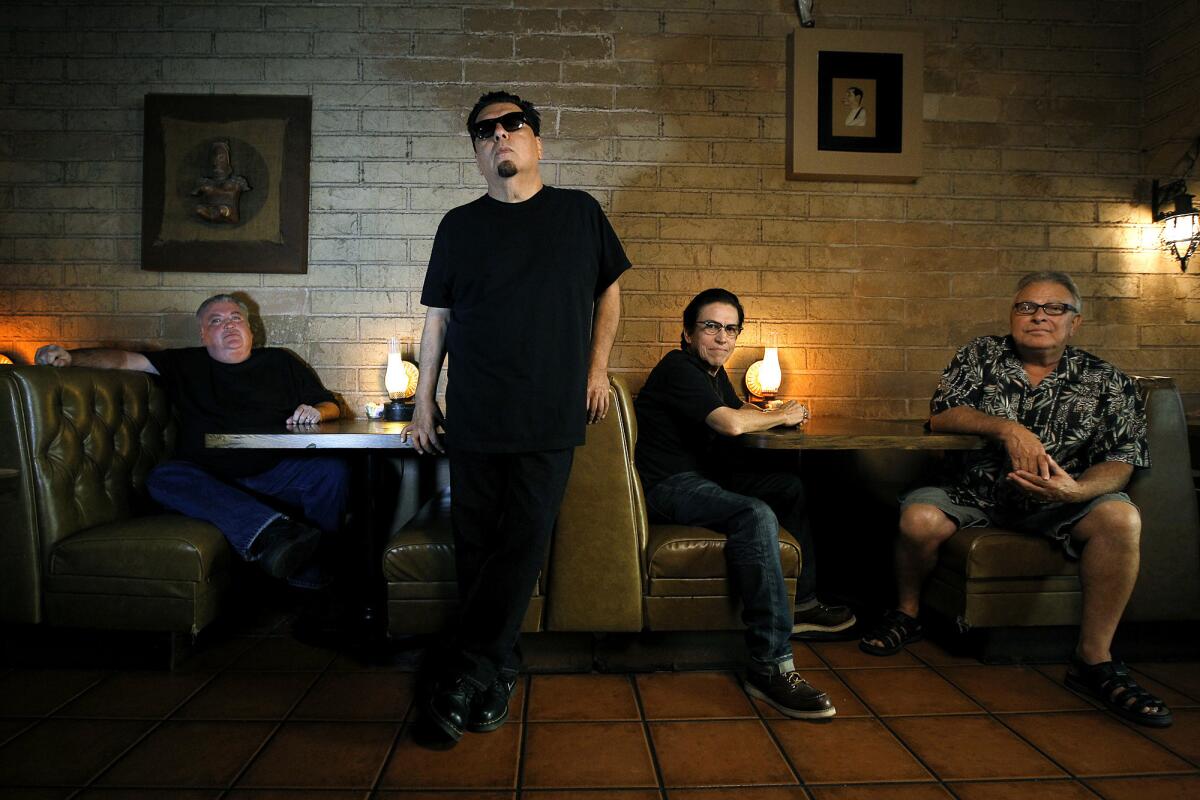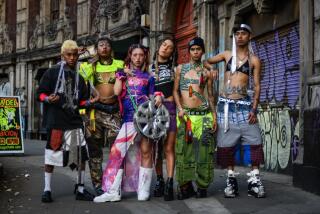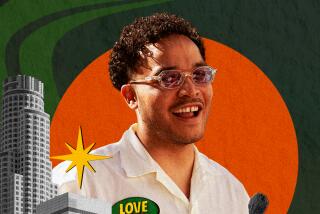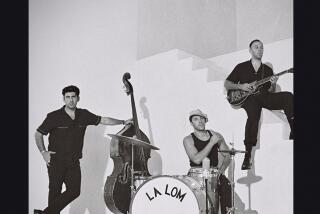From the Archives: When ‘Kiko’ shook the pop music world and it all changed for Los Lobos

Los Lobos’ David Hidalgo, left, Cesar Rosas, Louie Perez and Conrad Lozano at Lucy’s El Adobe Restaurant in Los Angeles in 2013.
- Share via
The East L.A. band Los Lobos looks back in wonder at its 1992 album “Kiko,” which shook the pop music scene. This article was originally published Sept. 16, 2012.
STATELY, COOL-EYED DAVID HIDALGO took his place at the front of the stage, cradling an electric guitar.
“There’s a few little problem children in this album,” he told the audience at the Grammy Museum’s Clive Davis Theater in downtown L.A. A trickle of laughter ran through the crowd.
Then Hidalgo and his Los Lobos bandmates -- guitarists Louie Perez and Cesar Rosas, bassist Conrad Lozano, saxophone-keyboard player Steve Berlin and drummer Enrique “Bugs” Gonzalez -- hoisted their instruments and stroked the first notes of “Dream In Blue,” a jaunty, sharply syncopated blues-rock tune that jitterbugs across a spooky, oddly exhilarating nightscape:
“I flew around with shiny things/ And when I spoke, I seemed to sing/ High above -- floating far away.”
As the aficionados at last month’s Grammy gig knew, “Dream In Blue” is the opening track on “Kiko,” the 1992 Los Lobos album that’s regarded not only as the East L.A. band’s breakout disc but as one of the most innovative and influential pop-music declarations of the Bush-Clinton era, along with Nirvana’s “Nevermind” and Public Enemy’s “Fear of a Black Planet.”
But while Nirvana sneered and Public Enemy fumed, Los Lobos dreamed up a cinematic vision of pop music’s future. “Kiko” was the introspective outsider, the cafe con leche-hued bilingual cousin that crashed the ‘90s hip-hop house party and gracefully side-stepped the grunge-rock mosh pit.
SIGN UP for the free Essential Arts & Culture newsletter >>
The Chicago Tribune, L.A. Times and New York Times proclaimed the disc a masterpiece. The Wall Street Journal compared it to “Sgt. Pepper’s Lonely Hearts Club Band.”
Two decades later, the little problem children of “Kiko” are all grown up and being honored with a newly remastered 20th-anniversary edition, including bonus material and demo versions of album tracks, released last month by Shout! Factory. The occasion is also being marked with the debut on CD, DVD and Blu-ray of “Kiko Live,” which captures the band’s never-before-issued February 2006 performance of the album at the House of Blues in San Diego. A Hollywood Bowl concert on a bill with Neil Young and Crazy Horse looms next month.
One late-summer afternoon, as the record’s multiple Grammy Award-winning fathers gathered in a Shout! Factory conference room in West L.A., they expressed lingering wonder at their quirky progeny.
“It was almost this thing that just kind of had its own life,” said Perez, the band’s principal co-songwriter with Hidalgo. “I think all of us can agree that there was something at work there that we didn’t have a whole lot to do with.”
An aural collage of Boyle Heights magical realism, gritty urban rock, shuffling roadhouse blues, surreal jazz textures and haunting poetic imagery, “Kiko” was epic in its genre-bending ambitions. And it may have saved a band that, by the early 1990s, had begun to lose sight of its soul.
Founded in 1973, when Garfield High School friends Perez and Hidalgo teamed with Rosas and Lozano, Los Lobos were Chicano hometown heroes. During their first dozen years of existence, they’d transitioned from Top 40 covers to harder-edged blues-based rock. They earned respect but sold few albums.
All that changed in 1987 when the band scored a No. 1 hit with its remake of “La Bamba,” the title tune of the Ritchie Valens bio-pic starring Lou Diamond Phillips. But the success of “La Bamba” locked the group’s popular image into that of a feel-good, retro-rock party band.
“‘La Bamba,’ it was so over-the-top, the reaction,” Hidalgo said. “It was fun, it was a cool ride for a while, but kind of artificial. It came and it went.”
Los Lobos tried to regain its artistic bearings with an album of traditional Mexican music, “La Pistola y el Corazon” (1988), and a rocker follow-up “The Neighborhood” (1990). But increasingly the band was feeling trapped by what Hidalgo calls its “self-imposed limitations” of keeping musical genres in separate boxes.
Los Lobos was also being chewed up by the record industry’s star-maker machinery. The band started losing money on tours, partly because it was hitting the road with two buses and Hollywood-level production values.
“We felt like we had been sold a bill of goods and we’d made mistakes and we just had this attitude, kind of angry -- angry at ourselves,” Berlin said. “The attitude was, ‘We’ve got nothing to lose, let’s just do whatever we want to do.’”
Thus was “Kiko” born, and for the first time the band drew on all its myriad influences: blues and zydeco, mariachi and Clapton-esque classic rock, Motown soul and country, Tex-Mex and 1940s big-band jazz. Perez’s lyrics enfolded Aztec mythology, Japanese renga and Borgesian philosophical musings.
Producer Mitchell Froom, who earned a Grammy nomination for his work on the album, said that Lenny Waronker, then president of Warner Bros. Records, had encouraged Los Lobos to take a creative leap with “Kiko.” The band was happy to oblige. Working closely with Froom and engineer Tchad Blake, Los Lobos stretched chords and juxtaposed pristine acoustic guitar lines with fuzzed-up percussion. They dared to follow a traditional son jarocho paean to a saint with an abused woman’s country-blues-rock cry in the dark.
“Tchad and Mitchell kind of created this environment where we were always just trying things,” Perez said. “We just felt kind of liberated and free.”
Among the innovations were the vibrato-laden saxophone-sound-loops on the song “Kiko and the Lavender Moon,” which someone suggested sounded like Duke Ellington’s orchestra playing “Three Blind Mice.” Most tracks were recorded in one or two takes. “We worked very quickly,” Froom said. “Now with Pro Tools all this stuff is so easy. Back then it wasn’t.”
Tapping into the band’s collective subconscious -- its frustrations, self-doubts and yearnings -- “Kiko” also channeled the roiling id of a city that was becoming an ethnically mixed metropolis. Ruben Martinez, a professor of literature and writing at Loyola Marymount University, said that the album “hit the zeitgeist perfectly in L.A.” on the eve of the 1992 riots.
“L.A. had become a brown city, and the way people imagined it was shifting,” Martinez said. “And the melange of sounds that they were bringing in totally reflected the integration that was taking place culturally, even as the city was coming apart in the riots.”
For Los Lobos, there would be no looking back after “Kiko.” Never again would they fail to heed their own instincts.
The band would continue to push its artistry forward with the equally radical “Colossal Head” (1996) through to “The Town and the City” (2006) and “Tin Can Trust” (2010). Various group member’s side projects, like the Latin Playboys, have extended that experimental legacy, paving a path for genre-busting third-generation Chicano bands like Ollin and Quetzal, and fourth-generation groups like Las Cafeteras and La Santa Cecilia.
And if Los Lobos, which turns 40 next year, ever falls into a creative funk again, they will know where to turn.
“When you go through something like that, what’s the first thing you do?” Perez said. “You open up your high school annual or something to find out who you really are: ‘Yeah, there I am with those big ears.’ You just have to keep moving up the ladder until you kind of find yourself again.”
More to Read
The biggest entertainment stories
Get our big stories about Hollywood, film, television, music, arts, culture and more right in your inbox as soon as they publish.
You may occasionally receive promotional content from the Los Angeles Times.











